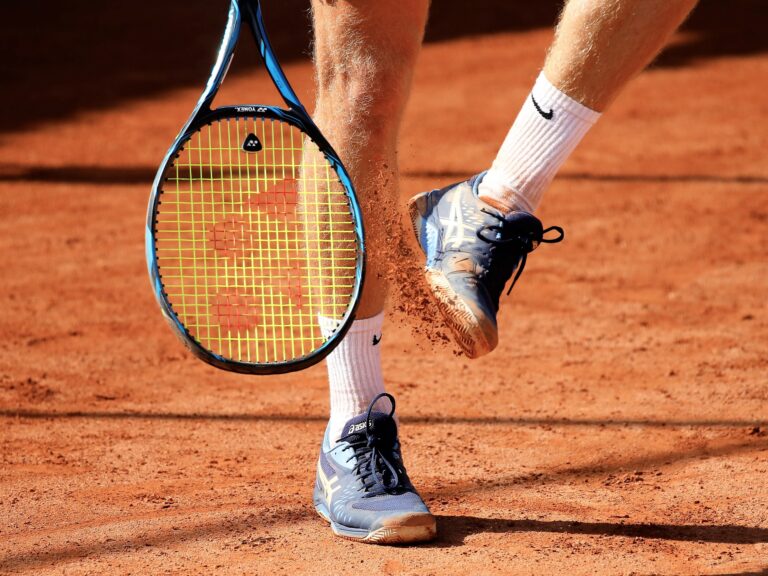Inspiration
I have never been a big bagel person – that is not to say I don’t enjoy bagels, everyone enjoys bagels – but with respect to my frequency of bagel consumption, I daresay I struggled to push more than one bagel consumed per month. I have no excuse, though, as New York City has its own take on the tasty bagel that originated from the Ashkenazi Jewish community of the city. Compared to the store-bought Montreal-style bagel, the New York bagel is larger and fatter, with the typical bagel weighing in at 6 ounces (170 grams) of tastiness.
Recently, as in the past month or so, I have consumed at least a half-dozen bagels, either by way of grabbing a quick bite to eat with a friend or as a quick 6 am snack eaten while walking to the hospital. I prefer the “flagel,” or flat bagel, supposedly invented in 1994 in Brooklyn by Tasty Bagel. Dollop some blueberry or strawberry or walnut raisin cream cheese… scrumdiddlyumptious!
One of the thoughts that coursed through my mind while waiting in line to make my order involved the concept of a bagel in tennis, in which one player crushes another 6 – 0 in a set. I suppose the inception of this thought arose given the upcoming U.S. Open in Flushing Meadows in conjunction with the aroma and sight of hundreds of bagels and dozens of bagel toppings at the bagel store.
So, I decided to do some “research” and provide context on bageling in tennis. All statistics presented are just prior to the start of the 2021 U.S. Open.
On Tennis Bagels
There doesn’t appear to be any definitive origin as to how the term “bagel” arose to describe a 6 – 0 set in tennis, but the obvious etymological origin would be the morphologic similarity of the number zero and the bagel shape. In any case, sites have previously conducted their own analyses on this topic, including at the Tennis Abstract and Tennis Warehouse websites, but I’ll present my own spin on it.
I should note that all of the raw data come from the Ultimate Tennis Statistics website. As the site does not maintain an analogous record book for the Women’s Tennis Association (WTA), you will notice that all players analyzed are from the Association of Tennis Professionals (ATP) tour. The website does have some extremely niche statistics, though – check it out!
To preface, I only used the list of players who have dished out at least fifty bagels in their career, which is a list comprised of only 48 ATP players. I wanted to focus on these individuals as they consist of many of the top players in tennis history, so I felt that analyzing their bageling tendencies, whether in consumption of bagels or in dishing out bagels, would be a fun and tasty exercise.
0 - 0: On the Players with 50+ Bagels
These are the list of players I included, by chronologic order of turning professional, along with some of their career statistics. The horizontal dividers separate out players by decade with respect to year turned professional.
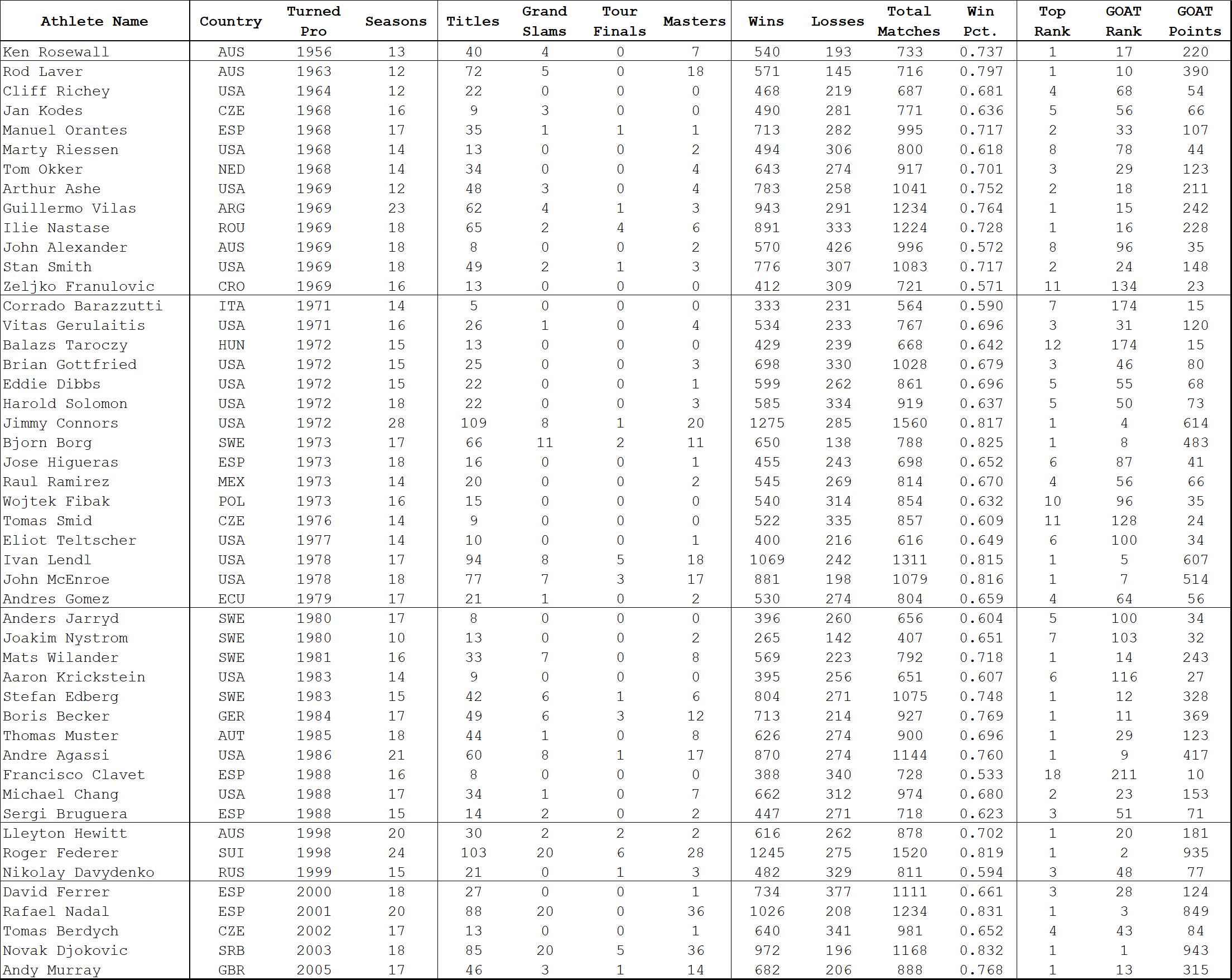
1 - 0: On Eating and Dishing Bagels
Let’s start with an easy one: which of these players have eaten and dished out the most bagels? The order of players presented is by the total number of bagels dished throughout their respective careers.
Jimmy Connors leads the way by a long shot with 198 bagels dished out in his name. Of the players currently active, Rafael Nadal has served up 116 bagels to his opponents.
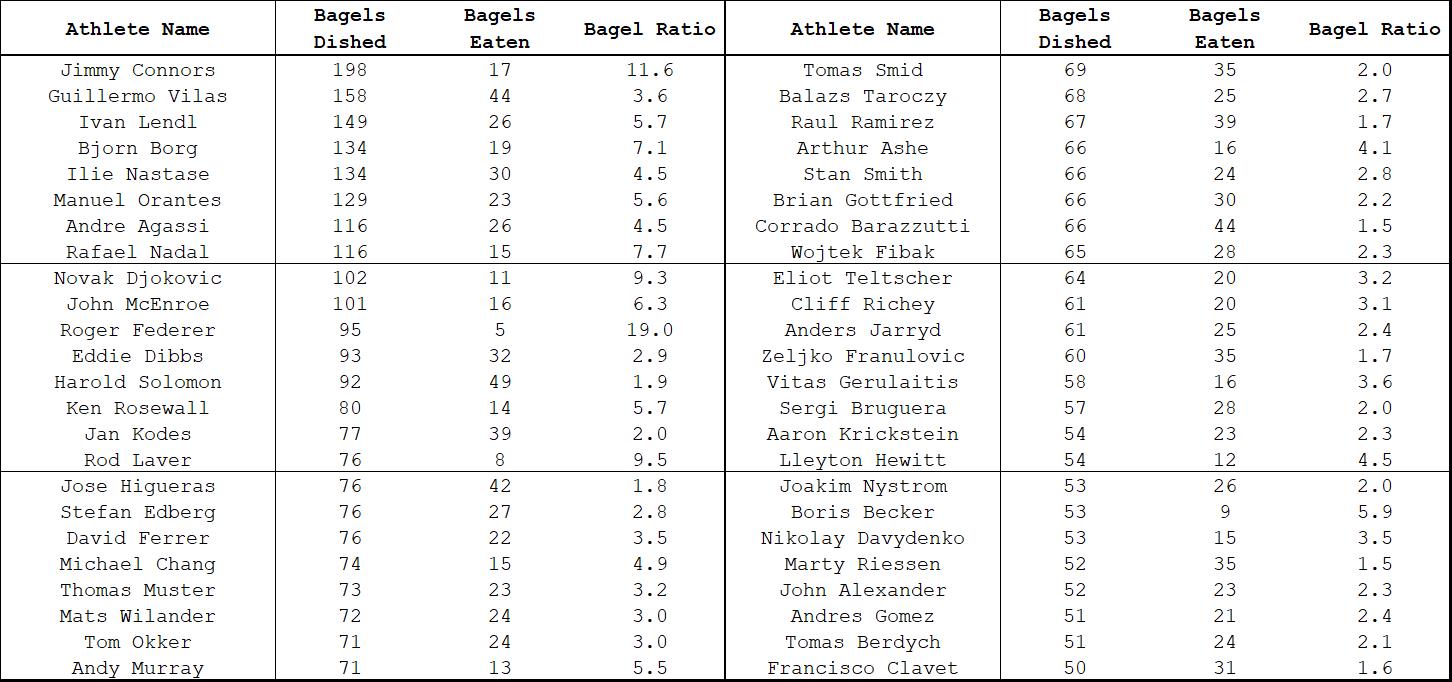
2 - 0: On the Bageling Ratio
I found that the bageling ratio, or the ratio between bagels dished: bagels eaten to be a fairly compelling statistic. If we order by the bageling ratio, we find Roger Federer at the top of the list, no doubt due to only suffering five bagels eaten over his illustrious career. In fact, of the top 48 bagelers, only Rod Laver and Boris Becker have fewer than ten bagels eaten, whereas everyone else is in the double-digits.
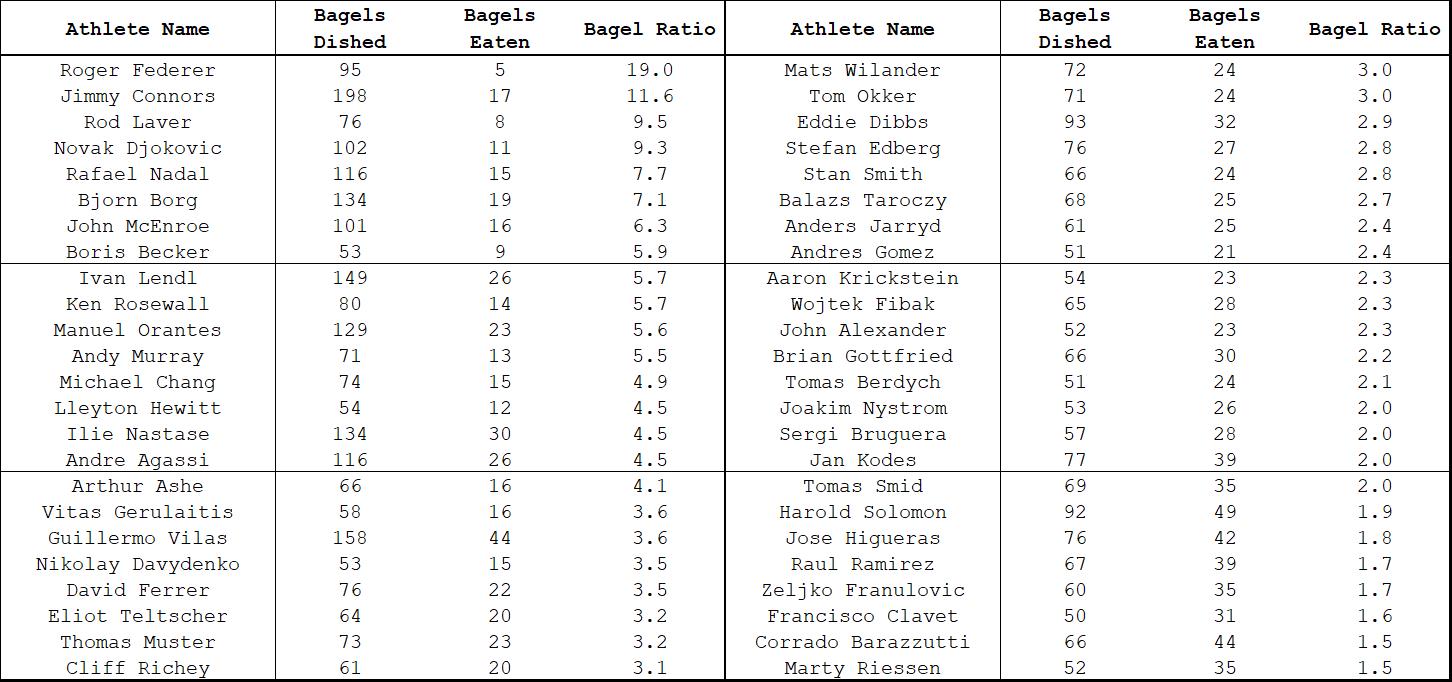
3 - 0: On Bageling Comebacks
On rare occasions, one eats a bagel, finds out it isn’t tasty at all, and sends back a response to the bagel-maker. On the other hand, there are those occasions in which one dishes out a bagel but finds that the customer sends it back with force! Here’s a look into the losses suffered when dishing out bagels and the wins gained when dropping a set 6 – 0.
Ordered by most likely to win after dishing out a bagel:
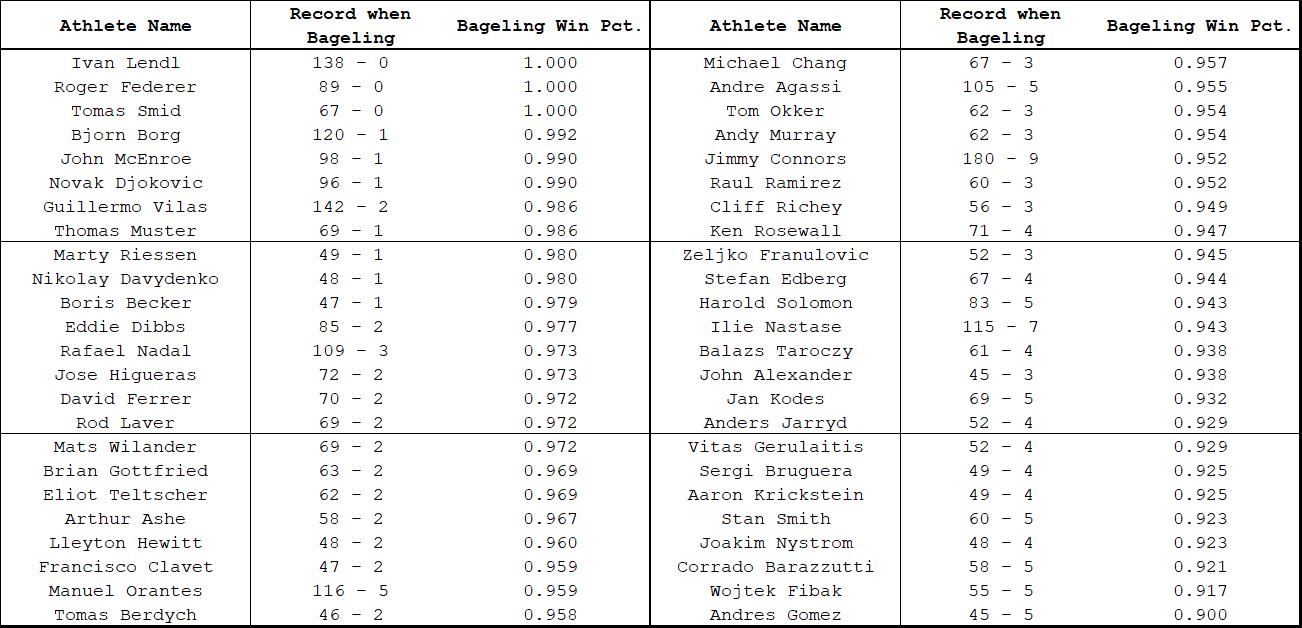
Incredibly, Ivan Lendl, Roger Federer, and Tomas Smid have never lost a match in which they have bageled their opponent. Of course, the bageling win percentage is 90%+ for all of these players, so the majority of them only dropped a few matches at most, but still, perfection is perfection!
Ordered by most likely to make a comeback after eating a bagel:
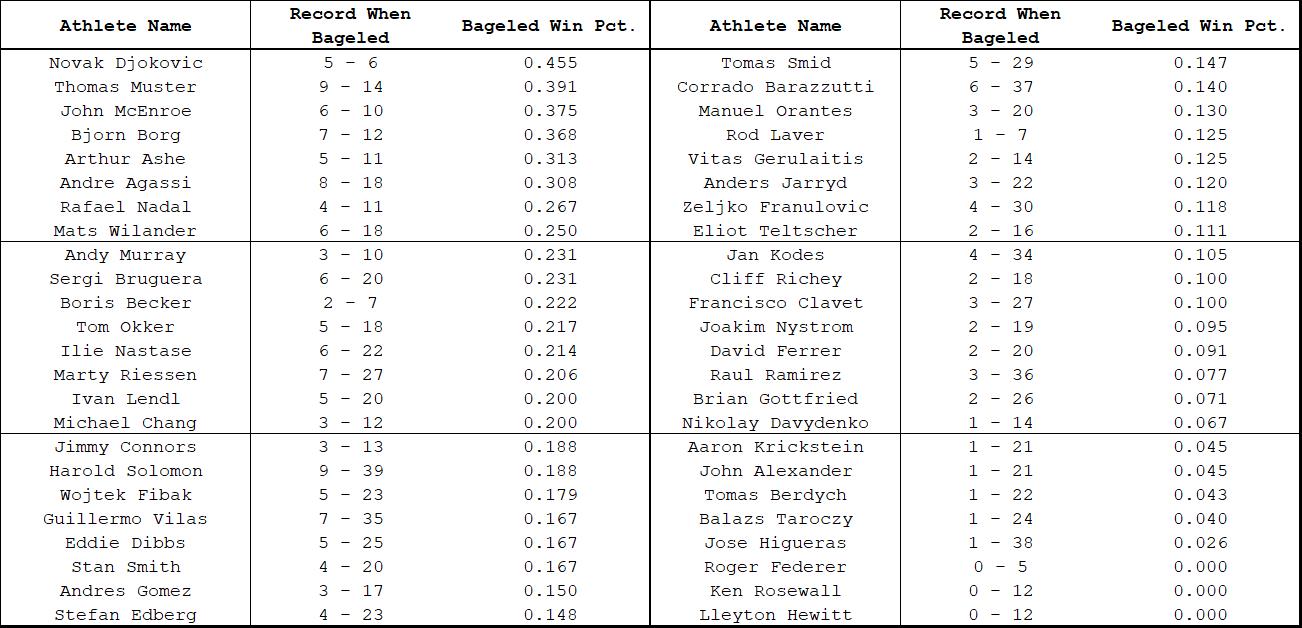
This table really shows the mental fortitude of Novak Djokovic, who has won 5/11 matches in which he has been bageled!
4 - 0: On Double and Triple Bagels
Sometimes, one bagel is simply not enough! Here’s the rundown of when these players dished out or ate multiple bagels in a match. I counted a triple bagel as 1.5 double bagels for tallying purposes.
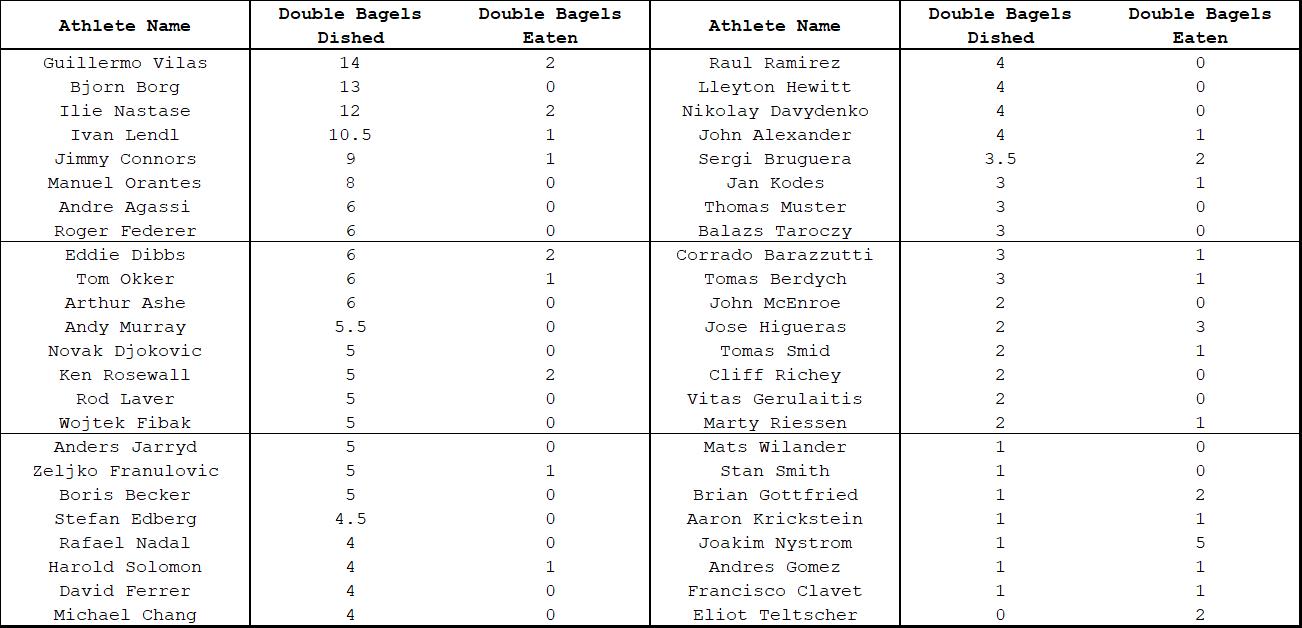
Of these players, Stefan Edberg (Wimbledon 1987), Ivan Lendl (US Open 1987), Sergi Bruguera (French Open 1993), and Andy Murray (Davis Cup 2011) have dished out a 6 – 0, 6 – 0, 6 – 0 triple bagel to their opponent.
5 - 0: On Frequent Bagelers
Of course, many of the top bagelers had long careers during which they were able to set up shop and cumulate a large number of bagels delivered to their opponents. However, of these tennis players, who has the highest bageling rate from a per set basis?
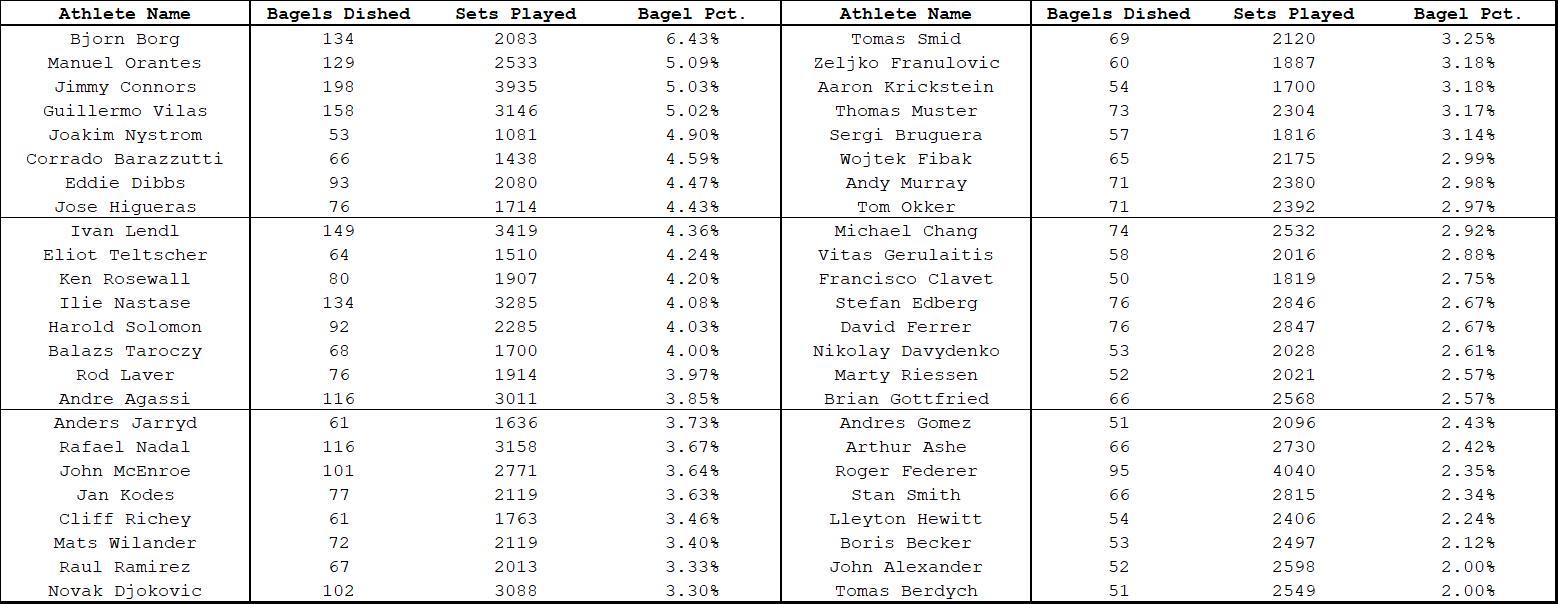
Bjorn Borg, the Ice-Man, cracks the top of the list with a bagel percentage of 6.43% of sets played, or a bagel roughly every 15.5 sets.
6 - 0: On GOATs and Bagels
It is of little surprise that we find such names as Federer, Nadal, Djokovic, Connors, and Lendl on this list. Yet other all-time great players are noticeably absent; of the 48 players with at least 50 bagels, the average GOAT rank is 52nd (range: 1 to 211). Eighteen of the top twenty players ranked by GOAT status are found within the list of 48 players. The two unlisted top-twenty GOATs, Pete Sampras (rank 6, 523 GOAT points) and John Newcombe (rank 19, 210 GOAT points), have 37 and 32 bagels to their names, respectively.
For these 48 players, here’s a table showing the number of bagels and GOAT status as determined by the Ultimate Tennis Statistics website.
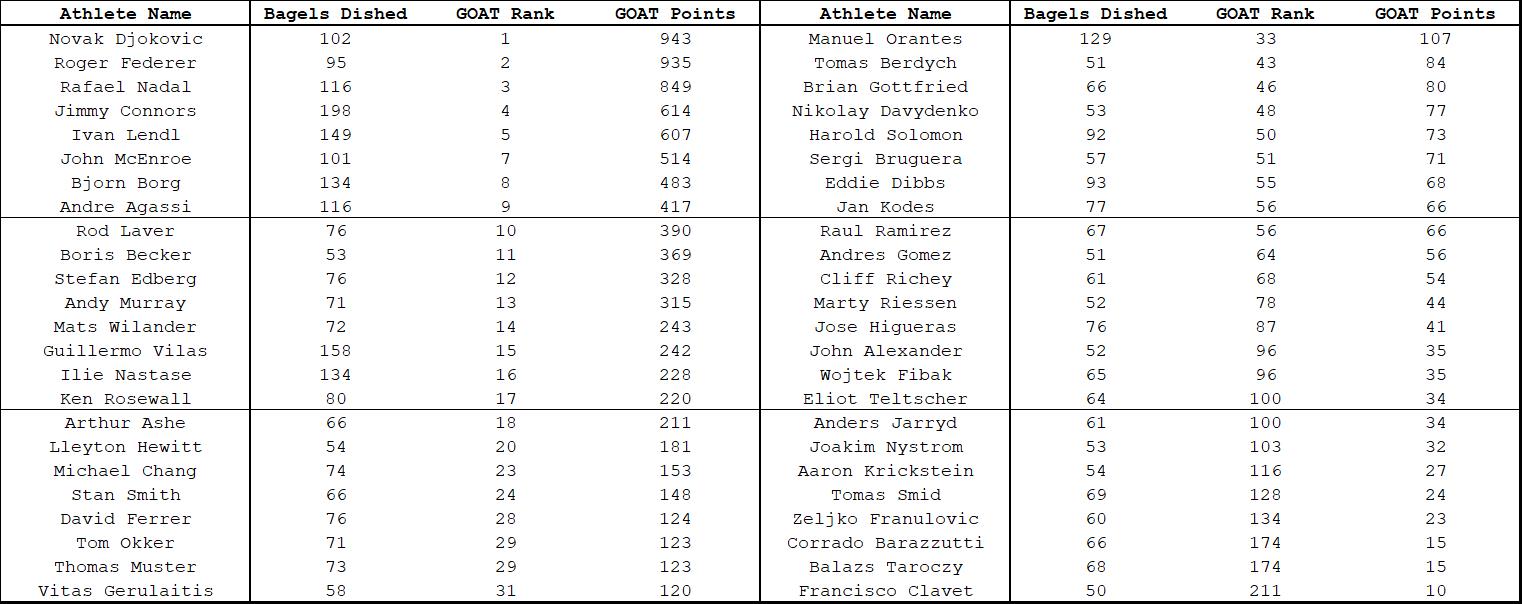
A correlation doesn’t jump out between number of bagels delivered and GOAT status, though most of the GOATs do find themselves on the most-bagels-dished list.
Alrighty, I could probably go on to the second set and continue with this analysis, but I am quite full now from eating bagels, so I’ll leave it at this.
Reflection
I hope this post gives you some food for thought! If you are ever in the New York City area, try out the bagel with white fish from Sable’s Smoked Fishon 76th and 3rd Avenue. Seriously tasty stuff!
Note: There is a similar term in tennis called “breadstick,” in which a player wins a set by a score of 6 – 1. I don’t find this statistic as compelling, perhaps because I prefer consuming bagels to breadsticks, but further analysis on the frequencies of breadsticks is of potential interest to explore.
